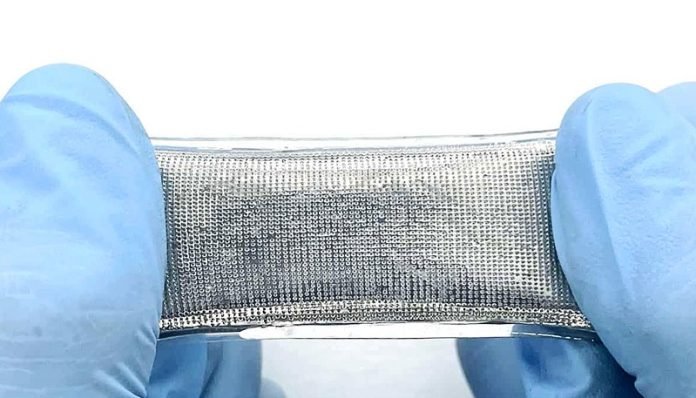
A new technique uses liquid metal to create an elastic material that is impervious to both gases and liquids.
Applications for the material include flexible batteries and other packaging for high-value technologies that require protection from gases.
“This is an important step because there has long been a trade-off between elasticity and being impervious to gases,” says Michael Dickey, professor of chemical and biomolecular engineering at North Carolina State University.
“Basically, things that were good at keeping gases out tended to be hard and stiff. And things that offered elasticity allowed gases to seep through.
We’ve come up with something that offers the desired elasticity while keeping gases out.”
The new technique makes use of a eutectic alloy of gallium and indium (EGaIn). Eutectic means that the alloy has a melting point that is lower than its constituent parts. In this case, the EGaIn is liquid at room temperature.
The researchers created a thin film of EGaIn, and encased it in an elastic polymer. The interior surface of the polymer was studded with microscale glass beads, which prevented the liquid film of EGaIn from pooling.
The end result is essentially an elastic bag or sheath lined with liquid metal, which does not allow gases or liquids in or out.
The researchers tested the effectiveness of the new elastic material by assessing the extent to which it allowed liquid contents to evaporate, as well as the extent to which it allowed oxygen to leak out of a sealed container made of the material.
“We found that there was no measurable loss of either liquid or oxygen for the new material,” says Tao Deng, professor at Shanghai Jiao Tong University and co-corresponding author of the study in the journal Science.
The researchers are also conscious of costs associated with manufacturing the new material.
“The liquid metals themselves are fairly expensive,” Deng says.
“However, we’re optimistic that we can optimize the technique—for example, making the EGaIn film thinner—in order to reduce the cost. At the moment, a single package would cost a few dollars, but we did not attempt to optimize for cost so there is a path forward to drive cost down.”
The researchers are currently exploring testing options to determine whether the material is actually an even more effective barrier than they’ve been able to show so far.
“Basically, we reached the limit of the testing equipment that we had available,” Dickey says.
“We’re also looking for industry partners to explore potential applications for this work.
Flexible batteries for use with soft electronics is one obvious application, but other devices that either use liquids or are sensitive to oxygen will benefit from this technology.”
Additional coauthors are from Shanghai Jiao Tong University and NC State.
The National Science Foundation, the National Natural Science Foundation of China, the Innovation Program of the Shanghai Municipal Education Commission, and Shanghai Jiao Tong University supported the work.
Written by Matt Shipman.



